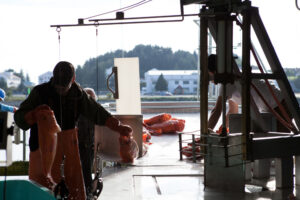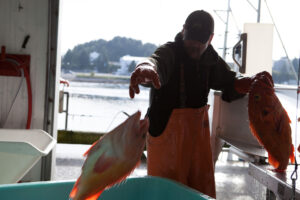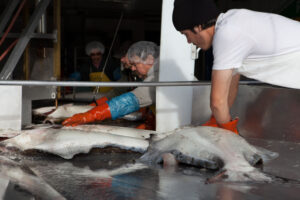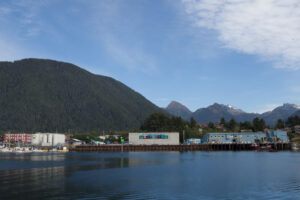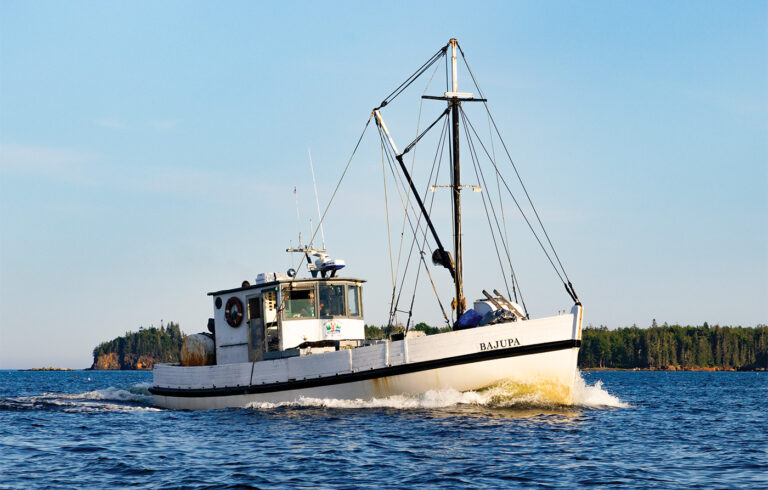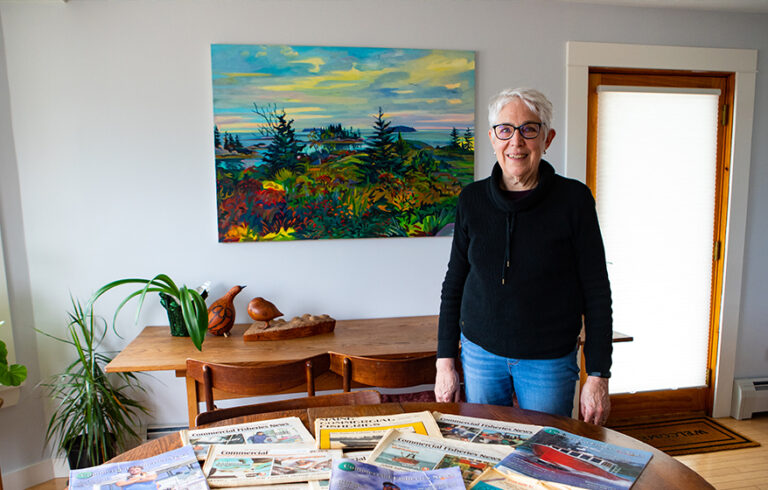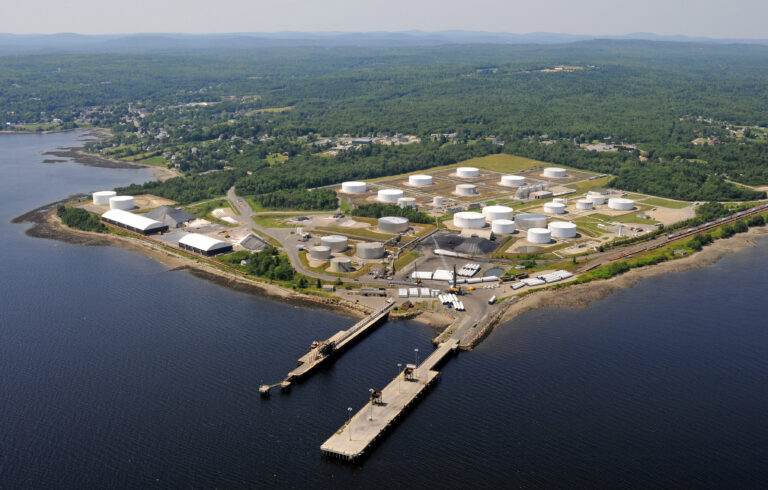
Every ounce is valuable. So valuable, in fact, that those difficult first cuts, if done poorly, will leave dollars on the floor.
It’s mostly a mechanized process, but the head and tail are removed with a handheld knife. Then the fish’s glistening body is placed on a short conveyor belt and moved to a device that splits it into filets.
Thought, care, and value—they are evident in and guide every phase of handling and processing this Alaskan salmon. And thanks to some innovative thinking decades ago, the men who haul these beautiful, iconic creatures from the sea to the plant can earn a living doing so.
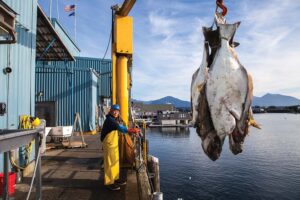
It’s only been an hour since the fish was landed in the waters off Sitka, one of Alaska’s busiest fishing ports, and brought to the Seafood Producers Cooperative (SPC). It is fresh, and about to have its picture taken. That’s not surprising, because the fish is indeed photogenic, its silver and pink streaks visible through the slurry of ice in which it is packed. But the digital photo is made so a three-dimensional image can direct the mechanized cutting, customizing it for this particular fish.
As the processing begins, Craig, wearing a hairnet and sporting a goatee, encourages me to look down through a window into a stainless-steel box. How strange and wonderful to see the inner workings of this machine. The fish approaches, and then the camera’s flash follows. A seeming perfect filet is suctioned tight against the conveyor belt so it can’t move as the robotic blades trim. Then skilled human hands “pin-bone” the meat, removing any remaining aesthetic or culinary imperfections.
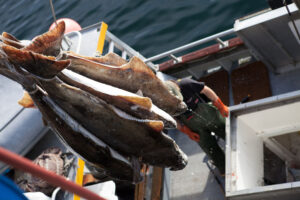
In this picture-perfect state, the filet is vacuum-packed and takes its place as the modern version of Alaskan gold.
It is as sophisticated and impressive a processing facility as I have ever seen, and it is owned by fishermen. And they are fishermen with clear-eyed views of the competitive market in which they operate. I observe and think of Maine, perhaps naively and idealistically; how might this success story be shared with the state’s lobster industry?
LANDING
F/V TYEE looks to be about 40 feet long, a wooden boat built in the 1920s, cared for and run by a long line of fishermen. She glides into Sitka harbor and takes her place among four other boats along the wharf. Hoists lower baskets deep into the hold where a crew of three works steadily, this final push ending three days at sea.
These are Alaskan long-line fishermen, famous for their commitment to “one hook, one fish” in catching salmon.
The urge to see more, to understand what hope may lie in this endeavor, draws me closer. I hang over the edge, maybe 15 feet above the deck, looking down through cables and beams. A glimpse into the hull, over the shoulders of Grunden-clad mariners, reveals more.
The fish are stacked head to tail, tail to head, indicating a handling that is methodical and deliberate. Fishermen step through the ice that engulfs the catch. “Bled and blasted,” the saying goes: bled immediately upon landing, gutted, and carefully filled with granular flake ice that works its way evenly throughout the fish and then blasted cold, fast, to ensure freshness.
Now hoisted onto the wharf, each fish is immediately graded as a 1 or a 2, based on quality. Sushi-grade is common here; these are some of the finest fish landed in the country. Once sorted, they are laid in a liquidy ice so fine that it suspends the fish, not allowing the weight of one to compress the meat of another.
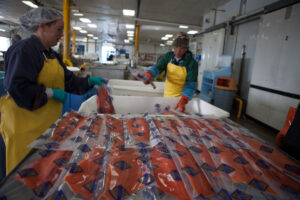
The salmon species include coho, king, chum, pink, and sockeye; they flow across the threshold under the eyes of careful workers. And it’s not just salmon that get the treatment. The striking red “yellow-eye,” Pacific halibut, and black cod are here, still alive, having made the trip to land from depths of 1,800 to 3,000 feet.
These fish are valuable, $6 or $7 a pound for a 5,000-pound haul—a $30,000 trip, maybe more. The captain will receive 70 percent now, his first advance. Later, in January, he will get his second advance, and if all goes well, another 30 percent that will make him whole against the original dock price.
Thirty to 40 boats a day land during the spring to fall season, each unloading an average of 3,000 pounds of fish.
FISHERMAN PROCESSOR
At Seafood Producers Cooperative, there is no invisible line that fish cross—no transformation from belonging to the fisherman and then to the processor. That’s because the fisherman lands at his own processing plant.
Don Seesz, 71, has been a member of SPC since 1971. A native Minnesotan, he moved to Alaska in 1968, and has spent most of those years trolling for salmon during the summer fishing season, which dovetailed well with his junior high school teaching job.
“It’s been a wonderful, wonderful deal,” he said of the cooperative. There was a time, though, that he wasn’t entirely on board with the concept; he actually thought about leaving the co-op when it assessed each member a $1,500 fee.
“In those days, $1,500 was a lot of money,” Seesz recalled. “We were struggling,” he said of the co-op. “We were trying to build a plant.” Older members talked him down, he said. Seesz stayed with the group, and has never regretted it.
“You get the most for your product,” he says today. “I believe in the co-op way. It’s managed by fishermen, for fishermen. The profit plows back to you, the fisherman.”
Starting the organization back in 1944 was not an obvious move, he said. “It was a leap. But they had the vision.”
Seesz is one of 540 co-op members, 99 percent of whom are trawl fishermen, a like-minded group committed to the highest standards of workmanship which translates into maximizing the value of their catch. In February, these fishermen get their settlement payment, based on overall profits minus expenses. It could be another 8 percent above dock price. This is real money.
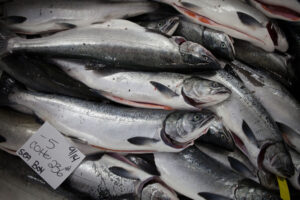
But it wasn’t always like this.
It started back in the 1930s, when a group of halibut fishermen from Seattle were angry, realizing they had settled for being merely price takers, getting next to nothing for their catch, and watching from a distance as the fish oil business, their primary market, collapsed. They had no control of their future, and lacked the shoreside business skills to change that.
Many had heard about fishermen in British Columbia’s Prince Rupert Sound who had banded together to form a harvester and producer cooperative. The rumor along the coast was that it was succeeding.
It was. Decades earlier, the Prince Rupert fishermen had begun producing their own fish oils and selling them in global markets. As markets shifted and synthetic vitamins emerged to replace those fish oil supplements that were once given to children every morning, those Prince Rupert fishermen were able to respond quickly and create new markets for their product.
The Seattle fishermen followed the Prince Rupert Sound fishermen’s lead and formed, as it was first known, the Halibut Producers Cooperative, today the Seafood Producers Cooperative.
The fishermen who served on the board of directors of the company were known to be argumentative and conservative. Rather than risk building their own processing plant, they opted to lease excess processing capacity from other facilities along the North Pacific coast. It would stay this way for the next 35 years.
QUALITY, QUALITY, QUALITY
By the late 1970s, it became clear that the only way to guarantee a quality product would be to own and control the processing infrastructure. This was perhaps the most important decision they would make. They broke ground on their own processing plant in Sitka. They would process their own fish and get a bigger chunk of the eventual sale price back in their pockets.
But it wasn’t all smooth sailing. By the late 1990s and early 2000s, Alaskan salmon fisheries were facing disaster. The annual catch was fluctuating unpredictably. Massive amounts of farmed salmon from around the world had devastated salmon values. Fishermen weren’t making enough to make ends meet, and the co-op was under financial stress. A new approach was needed, and the renamed Seafood Producers Cooperative couldn’t take it on alone.
Fishing is Alaska’s second-largest industry after fossil fuel extraction, and it is the state’s largest employer. The salmon crisis was more than an SPC problem; it was a statewide problem, and the state of Alaska responded, creating a 50 percent tax credit for fishing-related infrastructure investments.
The SPC moved aggressively, expanding its cold storage and processing equipment in Sitka. It also hired someone who would redefine the business.
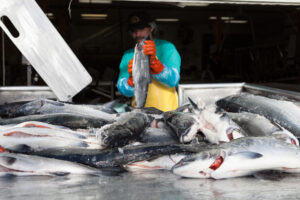
In 2002, food industry veteran Tom McLaughlin was brought in as the new CEO. Previously, he had worked at Perdue, the national poultry processing company, as its vice president of marketing, and he also held marketing posts for other fish and food firms.
The fishermen on the SPC’s board of directors gave him a straightforward charge: Get us out of the commodity business and into the value-added seafood business. A white-haired, blue-eyed version of actor Willem Dafoe, McLaughlin took a no-nonsense approach to the challenge. He viewed farmed salmon, the industry’s market competitor, as an opportunity. He knew the SPC couldn’t feed the world with its fish; the volume wasn’t there. He would let the fish farmers have the low-value global commodity market.
McLaughlin also understood that farmed salmon had created a global appetite for the fish. Where there is a global appetite, there would be a niche to fill for discerning consumers. Shortly after starting, he shifted the company’s focus toward creating and filling that luxury—and lucrative—niche.
The company is now producing high-quality salmon for the best-paying markets in the world. Fishermen have noticed; the co-op now has 40 percent of the hook-and-line fleet within its membership. SPC lands and processes about 8 million pounds a year in Sitka alone.
And quality is the company religion. Each new member is trained by a fellow fisherman on how to handle the fish, and fishermen regularly walk the plant floor, making sure other members are maintaining that quality.
Seesz, a fisherman and SPC board member, said members are asked to leave the co-op if they can’t meet the handling standards that ensure quality product. It’s rare, but some members have been shown the door.
SHARE AND SHARING
A single share in the co-op costs $110. Once a member, each fisherman becomes vested in the company over the next seven years or more, paying in $15,000. There is no waking up one morning and withdrawing that investment. The profits come back out at the rate that members invested. Operating capital remains stable as old fishermen leave and new fishermen arrive.
Joining forces, as the fishermen have in Sitka, tends to come when times are bad, McLaughlin said.
“They could see the advantage of being able to market their own product,” he said of the founders of the co-op, but many fishermen “tend to look at a co-op as an answer when times are tough.”
Participants, McLaughlin stressed, have to look at the long-term benefits and be committed to waiting for the payout.
“Ninety-eight percent of the time, we give them more return on their money,” he said.
Jay Haun, 65, another member who lives in Bow, Washington, and travels north to Alaska to fish, worries about the next generation. He echoed McLaughlin’s observation about bad times driving decisions. “What I see happening with our younger members is that they’re using our co-op as an option,” he said, selling to SPC when prices on the larger market are low, then shopping their product around when prices rise.
The long view is the best way to evaluate SPC, he said. Since joining in 1974, “It’s made me just a ton of money,” Haun said, laughing.
SPC is embarking on a new strategy, selling directly to consumers rather than focusing on restaurants, he said. “We’re going to send fish to a distribution point,” where consumers can buy boxes containing fish portions.
“Younger people want to know the story behind the product,” he said, noting an important part of the local food movement.
ALASKA AND MAINE
Fishermen on the coast of Maine may be able to learn much from their counterparts on the shores of Sitka and Bellingham, Washington. Fishermen in Maine are limited to being price takers, and the harvesting cooperatives often are held captive by a limited number of large buyers. The boat price drops lower and lower and stays low for years. Marketing has been almost nonexistent.
Like the hook-and-line salmon fishery, Maine’s lobster fishery has a sustainably harvested product. But unlike the fishermen who own the SPC, Maine fishermen don’t have an organization they can join to lead them through these business decisions. Maine lobster remains an undifferentiated commodity, and the price stays low.
What will be the flash point that pushes Maine fishermen to take the next steps? Will the expansion of Canadian processing plants in Maine be the wake-up call? Will it be a stock collapse that limits supply while price remains low because of large Canadian landings? It is hard to say.
The idea of quality gets more than lip service at SPC, McLaughlin said. “They take great pride in the quality,” he said.
Maine has a number of small, successful harvester cooperatives. A few years back, the Island Institute convened a group to talk about creating a super co-op that could move the industry into food production. The group was wary of the risk, though a small co-op in Casco Bay took action and created Calendar Island Maine Lobster.
Meanwhile, consumers continue to pay top dollar for the high-quality Alaskan salmon, and fishermen in Sitka see far more of that dollar in their dividends than they ever hoped to see, thanks to the co-op.

